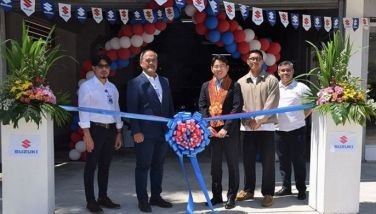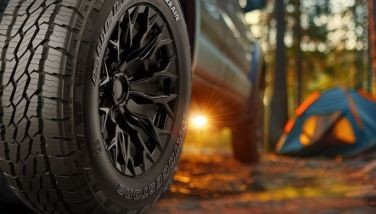Battle of the Bulge
August 6, 2003 | 12:00am
 The Philippines remains colonized by our American allies in spite of our declaration of independence on June 12 a hundred and five years ago. But this colonization is not through the control of our government but through the sheer influence America has on our people’s minds. The often-used term "colonial mentality" still persists in our every day ideology and attitude due to the influence of American media, television, music and fashion.
The Philippines remains colonized by our American allies in spite of our declaration of independence on June 12 a hundred and five years ago. But this colonization is not through the control of our government but through the sheer influence America has on our people’s minds. The often-used term "colonial mentality" still persists in our every day ideology and attitude due to the influence of American media, television, music and fashion.
One such Americanism we have espoused is their preference for sport utility vehicles or SUVs. We have shifted our preference from sedans to SUVs faster than our Asian neighbors that we even invented our own version, which is of course the Asian utility vehicle or the AUV.
Another Americanism we have espoused is the axiom "Bigger is better". In spite of our narrow roads and our shorter-than-the-average-Joe stature, we have shifted our SUV obsession from Japanese to American brands. For example, the previous Ford Expedition, despite its hefty price tag of almost two million pesos, was such a runaway winner that people actually gobbled up what Ford Motors Philippines could produce. While the excise tax made it prohibitive to import the SUV with its four-wheel-drive system (and in the process downgraded it to the status of a glorified 2-wheel-drive AUV along with other SUVs), people still lined up to buy what some call as the "ultimate rolling calling card" to flaunt one’s millions.
You see, people don’t buy Expeditions for their off-road capability, performance or utility. They buy it because it symbolizes wealth. (You could almost hear them say "Donde esta su Ford Expedition?" "Mi los Expeditiones son los verde y azul con las licencias 888 y 168.") After all, only people with the "spare" cash to the left of two million pesos can buy one and spend another hefty amount of moolah to continuously fuel and maintain the behemoth. The local market for these big American SUVs kept growing that it attracted General Motors (GM) Philippines to introduce its Chevy Tahoe and Norkis Automotive Resources Corporation (NARC) to launch its Dodge Durango. For the sake of our old-, nouveau- and trying-to-look-rich readers, let us compare these locally-available 4X2 SUV offerings from the "Big Three" American motor companies.
The Chevrolet Tahoe is shorter than the Expedition at 198.8 in and lower at 76.7 in but it is a tad wider at 78.8 in. (compared to the Ford’s 78.7 in). It has a curb weight of 5000 lbs, a ground clearance of 8.4 in. and a cargo volume capacity of 104.6 cu.ft. Its wheelbase measures 116 in. between wheel center lines. Both the Tahoe and the Expedition are classified as full-sized SUVs in the States.
The Dodge Durango, on the other hand, is classified as a mid-sized SUV and is like the baby bear in the Goldilocks story. At 193.5 inches, it is about as long as a Mitsubishi Pajero, albeit one that has been accessorized with a tire cover and extended bumpers. It stands at 72.0 in (about as high as a Nissan Terrano) and is the slimmest of the three Americans with a width of 71.3 in. It is a light weight at about 4550 lbs, has a slightly higher ground clearance than the Chevy at 8.5 inches while matching its wheelbase at 116 inches. However, these smaller external dimensions leave the Durango with the smallest cargo volume capacity of the group at 88 cubic feet. (In comparison, the Isuzu Trooper can swallow about 90 cu. ft. of cargo with its rear seats folded.)
The Ford Expedition is the proverbial cardboard-cut-out muscle man in the beach (you know, the one with fake muscles who gets sand kicked in his face) because it has the biggest body while having the smallest engine displacement. The 4.6-liter SOHC motor produces less power than the Dodge at 232 hp and a tad more torque than the Chevy at 291 ft-lbs. but the engine has to carry more weight with that heavy body. The towing capacity also suffers and is only a few pounds better than the Dodge at 6050 lbs (about 2950kg).
It is no secret that torque aids acceleration while horsepower counts for top speed honors, and that power-to-weight ratio has a hand in a vehicle’s overall performance. Granted that these SUVs are not race cars, but still, he who gets there first gets prime parking. The Dodge may be the nimblest among the three with its light weight, powerful engine and exclusive five-speed transmission but it may have to fight the four-speed auto equipped Chevy for top speed bragging rights with aerodynamics and power playing a huge role in triple-digit speed contests.
The Chevy Tahoe and the Dodge Durango both have similar wheelbase dimensions and rely on the proven live axle rear suspension. Since both were based on truck chassis designs, passengers may find the ride be a bit choppier than the Ford but only by a small margin. Both vehicles come with a 40/20/40 split second row seat and a manually-folding front-facing third-row seat, which increases the seating capacity to 10 persons. However, we Filipinos are known to squeeze in 12 persons and the cat given space like that.
At P1.850M, the 2003 Durango SLT 4X2 is the bargain buy among the three Americans and offers a little exclusivity, since not too many can be seen on our roads. Ditto for the Chevy Tahoe 4X2, although, the price of exclusivity goes up to P1.920M. The Ford Expedition XLT 4X2 is an irony because even if the price has crossed the threshold at P2.180M, its exclusivity is not guaranteed since you can see quite a number of them at any given time. Perhaps its desirability has helped increase the demand and its presence.
It has been said that the exclusivity of a product is directly proportional to its price: the higher the price, the more exclusive the product becomes. Whoever said that must not have heard of the American SUVs impact on the Philippine automotive market and the affluent (and not-so-affluent) Filipino’s keeping-up-with-the-Joneses, price-no-object attitude. Cramped parking space notwithstanding.
BrandSpace Articles
<
>
- Latest
Latest
Latest
April 8, 2025 - 5:00pm
April 8, 2025 - 5:00pm
March 11, 2025 - 11:00am
March 11, 2025 - 11:00am
February 10, 2025 - 2:30pm
February 10, 2025 - 2:30pm
February 6, 2025 - 4:36pm
February 6, 2025 - 4:36pm
Recommended



























